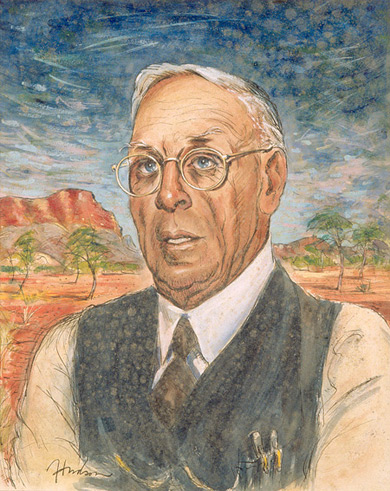John Flynn
The artist portrays Flynn in his trademark spectacles, waistcoat and tie. His friends described him as a meticulous dresser who maintained his immaculate presentation, even in soaring outback temperatures.
See a photograph of Flynn taking an outback shave at the National Library of Australia.
John Flynn is posed at a slight angle with his gaze directed away from the viewer. His mouth is painted slightly open, as though speaking.
How would you describe Flynn’s pose and expression?
What do you think he might have to say?
The artist uses setting to provide important information about John Flynn’s history and identity. The background in the portrait represents the vast inland country Flynn travelled for more than 39 years.
Create a self portrait that uses setting to represent your history or identity.
In Hudson’s portrait, two pens are tucked neatly inside the top left pocket, reflecting Flynn’s regular practice of taking notes wherever he travelled. These notes formed the basis for much of his published work, including his first book, The Bushman’s Companion.
Read The Bushman’s Companion online at the National Library of Australia.
Hudson’s portrait was created five years after John Flynn’s death. It is based on photographs and stories collected on his tour of inland Australia.
Does this information change the way you view the portrait?
What difference is there between a portrait based on a photograph and one painted from life?
Move your mouse over the portrait to
see the points of interest.
About the artist
Harry Hudson was a Melbourne author and artist. In 1955, he set out on a 32,000km tour of the outback to meet the doctors, nurses, airmen and radio technicians who had devoted their lives to the Royal Flying Doctor Service. Of the remarkable characters he met, he said, ‘The tyranny of time does not oppress these men of the Never Never country’.
Hudson’s portrait of Flynn featured as the frontispiece to his book, Flynn’s Flying Doctors, published in 1956. The book told the story of the Royal Flying Doctor Service and included 130 drawings from the author’s sketchbook.


